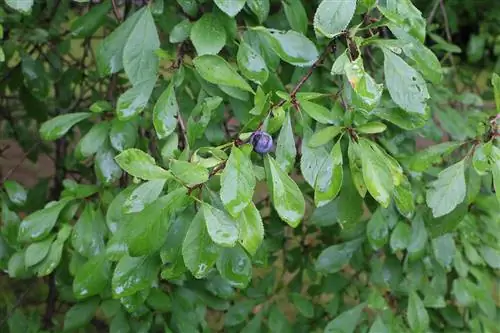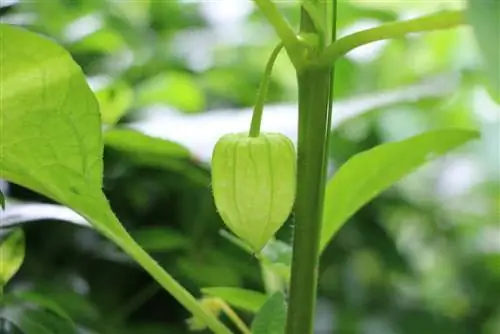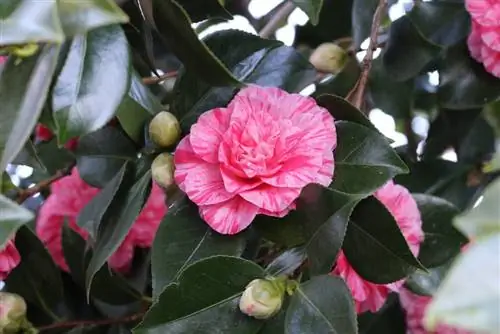- Author admin [email protected].
- Public 2023-12-17 03:39.
- Last modified 2025-06-01 06:48.
With peonies in your garden, you always know exactly when summer begins. The hardy perennials produce numerous, wonderfully fragrant flowers every year, which are also loved as cut flowers, and require little care to cultivate. However, they should be pruned regularly to stimulate flower growth and prevent possible diseases. Here we will give you some tips to help you care for and prune your peonies perfectly so that you can enjoy them for a long time.
Cutting
In general, sharp hedge or rose shears should be used to avoid crushing the plant stems. Carry out the pruning on a dry day so that no germs or dirt can penetrate the plant at the cut points. Peonies are hardy, they do not need to be covered for the winter after cutting.
As cut flowers
The peony is an elegant, fragrant and long-lasting cut flower whose flowers look impressive as a single bouquet or in combination with other flowers. Cut the flower stems long and remove the leaves if there are any on the stem; they rob the flower of its strength. If you want leafy greens, cut them extra. Always cut in your own garden early in the morning, make sure that the buds are not too small, otherwise they will not open in the vase. The stems are cut diagonally and placed in lukewarm water; if desired, you can add summer flower food from specialist retailers. Place the vase in a draft-free location. Change the water and cut the flowers again every two to three days. They should last at least 10 days.
Perennial peonies
When cutting outside in the garden, it is important to differentiate between shrub and perennial peonies; the requirements are different here.
The perennials are cut in autumn, preferably October - November, so that the above-ground parts of the plant can retreat into the ground and rest over the winter. Perennial peonies are cut back to a hand's width above the ground so that the dormant phase can begin. Cut the stems piece by piece so that too much pressure is not put on the cut edges and sap is released unnecessarily. The interfaces can then dry out quickly and close up. Examine the cut parts of the plant to see if there is any fungal infection anywhere. If this is the case, the clippings must not be disposed of in the compost, but rather in the household waste. If there are signs of fungal infestation, cut close to the ground or just below the ground so you can be sure you won't miss any remains.
Tree peonies
If you remove one or two leaves of the dead flowers immediately after flowering, this will give the plant enough strength and not waste it on producing seeds. In spring you can cut back the young shoots down to two or three eyes. More buds will form for the following year and the plant will also branch better.
The trees only receive a cleaning cut in late autumn, i.e. November - December, if necessary. The shoots are cut back to the first bud; you should not touch emerging buds. Before cutting, examine the branches and twigs to see whether a cut is even necessary. If your peony seems a bit bare to you, you can influence the new growth with a cut. Cut to the first branch, if possible in front of an external eye. However, avoid cutting in front of inner eyes. In general, the plants don't mind being pruned, but it can take one to two years to return to full bloom if you need to prune the peony more severely.
- also remove the leaves of the tree peonies in autumn
- Cut off wild shoots that sprout in spring directly on the trunk below the grafting area
Tip:
If the tree peonies have suffered frostbite, only cut the frozen parts after they have sprouted. This way you can see which shoots have died. Below are a few tips for cultivating your peonies so that you can enjoy the wonderful splendor and abundance of flowers of your peonies every year.
Substrate and soil
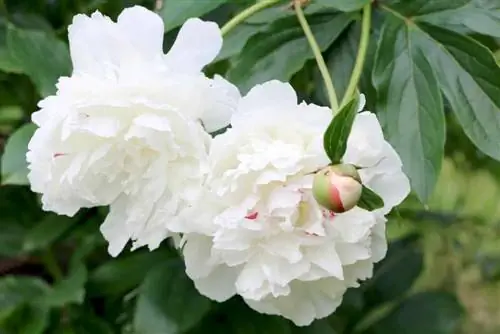
Loose, humus-rich soil is preferred. Deep soil is important, the roots reach deep into the earth and branch out there.
- When planting the young perennials, add horn shavings to the excavation, this saves the need for fertilizer in the first year.
- For shrub peonies, place the grafting point at least 5 - 10 cm below the ground.
- Make sure that the eyes of perennial peonies are at least 3 cm below the ground.
Location
Peonies are loyal to their location and want a sheltered, sunny place where they can stay for several decades. Among gardeners, the peony is also known as the lazy gardener's favorite plant. She doesn't like to be implemented.
Plants
Peonies are available as perennials and shrubs. They are usually planted in autumn.
Tip:
Never put new peonies in a place where a peony has already stood, as the soil is tired it will not develop properly and will only be looked after. Even replacing the floor will not bring any improvement at this point.
Propagate
If the perennials become too large or for some other reason it is unavoidable to move the plant from its original location, the entire perennial may not be moved to its new location, it is divided and treated like a young perennial. In this way, reproduction can take place through division.
Diseases and pests
The frugal plants can under certain circumstances develop fungal diseases, which is shown by wilted branches and stems during the vegetation phase. In these cases, pull out the affected stems of perennials directly at the roots and cut them off deeply in the fall. Do not dispose of in compost. Tree peonies should be pruned back to he althy wood in order to eradicate the fungus.
Conclusion
The frugal and long-lasting peonies are an asset to any garden that your grandchildren can also enjoy. By pruning in autumn, the perennial gains new strength and rewards the little effort with an enormous abundance of flowers and an intoxicating scent. Place your peonies in a sunny spot and the plant will thank you every year.
What you should know in brief
- Basically, the branches and leaves should only be cut back carefully. The following applies: less is more.
- It is very important to use high quality pruning shears that are very sharp.
- The cutting is always carried out above the so-called “sleeping buds” - shoots that only sprout in the next growth phase.
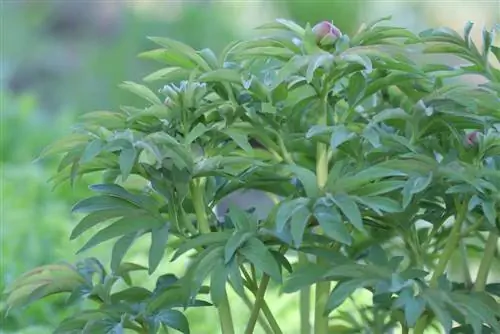
In absolutely exceptional cases, a peony can also be cut back severely: However, only situations in which there is an illness or the peony has been massively damaged by a storm or frost damage are considered exceptional cases. After such a radical cut, the flowering may stop for a year. So you shouldn't be surprised if the peony doesn't sprout for a season and looks rather pitiful. In any case, it should be left standing as it will recover on its own.
- In the case of a massive pruning, it is also important that a miracle sealing agent is applied to the incision sites.
- This prevents fungi or other diseases from entering the bush through the interfaces.
- Such miracle fasteners can be bought in any well-stocked hardware store or you can look around in various online shops on the Internet.
- Since peonies do not form strong trunks, it makes sense to purchase a good pair of secateurs.
- Alternatively, you can also rent garden tools from many hardware stores or garden specialist shops.


